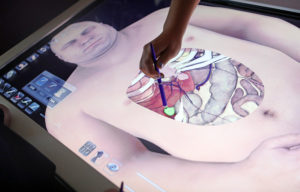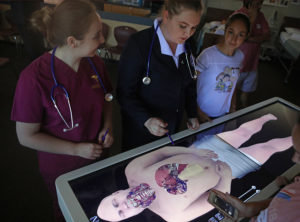The group of students gathered around the patient known as Carl inside a lab at Esperanza High as they performed the delicate procedure of removing a gallbladder.
Seniors Emilee Carr and Maddy Galvin directed the other students on how they should cut through the dense muscle tissue and move aside the liver covering Carl’s gallbladder.

After about three or four tries, the students finally managed to carve out the organ.
Of course, this wasn’t a real surgery. Students performed the procedure on a 3D tablet, with an iPad-like screen that’s about seven feet long, and just under three feet wide. The device is the newest addition to Esperanza High School’s Medical Sciences Academy.
The students and staff at the Placentia-Yorba Linda Unified School District campus unveiled on Tuesday the Anatomage Table, touted as the world’s most technologically advanced anatomy visualization system, offering dissectible human cadavers reconstructed in precise 3D models.
Esperanza High is the first high school campus in Orange County, and second in California, to use such a device as part of the regular school curriculum. In fact, only a handful of four-year universities in the state have an Anatomage Table for their science and medical programs.
“The surgical feature is my favorite part of the table,” said Galvin, who hopes to become a pediatric surgeon. “You can learn so much about how the human body works because this is so close to the real thing.”

The $75,000-device provides life-size modeling of the human muscular, skeletal, vascular, nervous and other systems. The funding came from a state Career Technical Education Incentive Grant. The models were created from real human cadavers.
The table has three human models, Carl, a male who died in his late 30s or early 40s; Vicky, a female who died in her late 20s; and Victor, a male who also died in his 20s. (Those weren’t the cadavers real names when they were alive.) Students already determined that Carl had an appendectomy before his death. Victor was a smoker, they deducted, because of the damage to his lungs.
The table’s screen responds similar to the one of iPad or other tablet. Using a stylus or their fingers, students can zoom in and out, rotate the 3D models and do similar tasks using the large touch screen. Users can view different parts of the human body from endless angles.
The table’s software will be updated annually, allowing for a wider variety of human models, or even higher resolution renderings.
“It’s excellent that students at this age now have access to these devices,” said Valerie Easton, a teacher at the school’s Medical Sciences Academy. “Some colleges are surprised when they learn our students are at this level of working with human bodies.”
Other teachers and administrators said the table will ensure more students at Esperanza graduate ready for college and careers.
